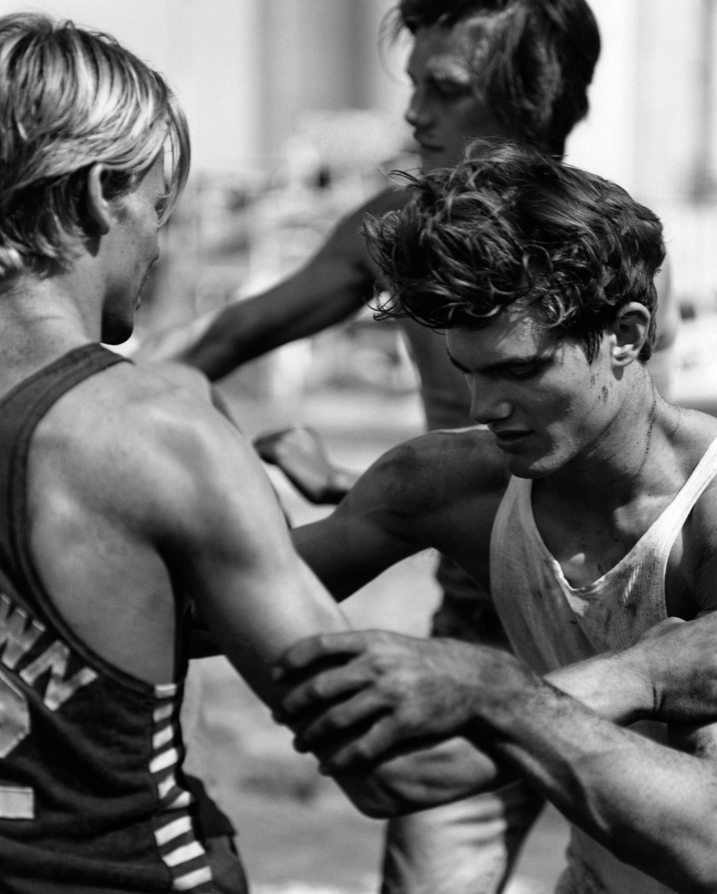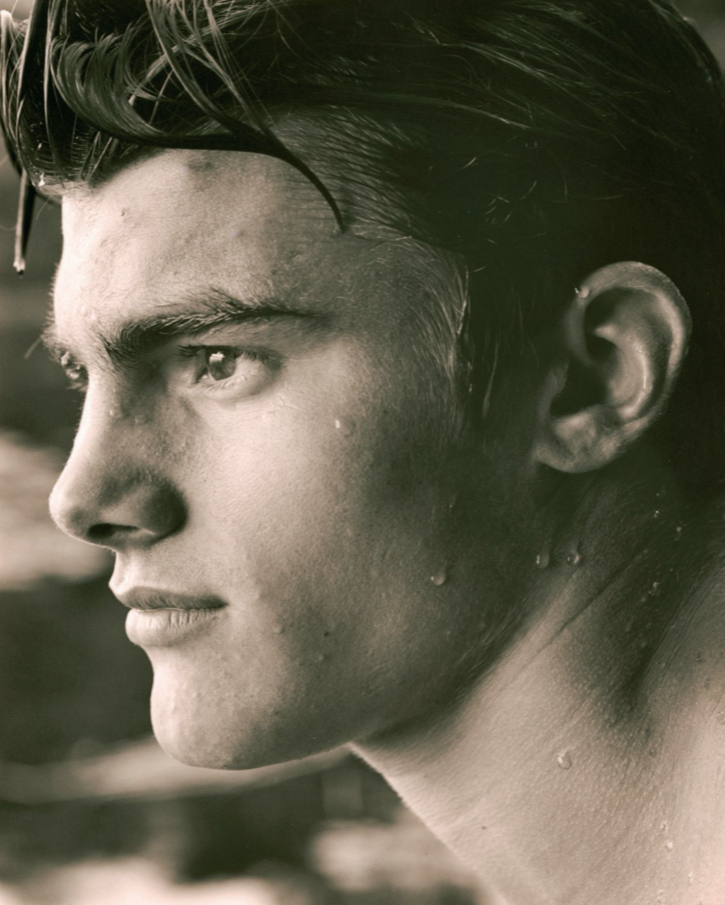THE CHOP SUEY CLUB
1998
Arena Editions
This book represents such a personal journey by the artist that the only apt description comes in the form of his introduction to the volume, the story of Bruce’s collaboration with his muse, Peter Johnson, presented here in full:
Even as it began, I knew I would never want it to end. It started in the spring of 1997 when I was driving through Joshua Tree National Park. The window was down and warm air was blowing through the car as I was editing some contact sheets while a friend of mine drove. We were listening to “Sweetheart of the Rodeo” by Gram Parsons, whose life ended in Joshua Tree in 1973. I thought about how Gram was so beautiful that Mick Jagger wrote “Wild Horses” for him. On my contact sheets I saw all these photographs I had just done in Los Angeles of Peter Johnson and giant poodles. The poodles came from Denmark, and were famous because they were like little ponies. They all had the “continental clip” which makes them look like they’re always going to a party. There were photographs of Peter lying down with a poodle covering him, because he was a little shy at that time about being nude. The poodle’s mouth was open and he looked like he was saying, “Oh, alright already!” As I paused to look at the desert one of the contact sheets flew right out of the window. We stopped the car and we all got out to look for it, but we couldn’t find it. After about ten minutes we gave up and I just started laughing, thinking that some hitchhiker or lonesome cowboy would come by someday and this piece of paper would catch his eye, and he’s pick it up and see this nude boy with a giant poodle.
I met Peter Johnson in the summer of 1996 at Dan Gable’s Wrestling Camp at the University of Iowa. I was in the gym with twelve hundred student who were there for two weeks to learn the art of wrestling. I was photographing a crowd of young wrestlers watching Dan give a demonstration, and in that crowd was Peter. He was fifteen years old, from a small town in Wisconsin. I spoke to his mom, Paula, and his dad, Dave, who both kind of laughed when they heard I wanted to take their son’s picture.
Before this, the only club I was ever a member of was the Outrigger Canoe Club in Honolulu. I liked the mai tis and their Gabby Pahinui music. After meeting Peter, my friends and I got together and started to take pictures of him the way camera clubs used to. We all realized that we’d been the kind of kids who’d grown up with tree houses where we hung out alone, except for maybe a dog or a stray cat we carried up there. Our afternoons were filled with looking at old postcards of elephants from Burma and photographs of Guy Madison and Robert Mitchum, reading Patsy and Hedy comic books, and listening to bootlegged copies of Frances Faye’s “Caught In The Act.”
When we were kids and our parents were out of town, my sister Barbara and I would get dressed up in our parent’s clothes. Sometimes I’d wear my mom’s and Barbara would wear my dad’s, and we’d put on an Original Broadway Cast Album and play and sing all the parts. I think my friends and I were doing the same thing with Peter. He was so open to all our conversations, from Nureyev to Neil Young; he’s just go there with us. All of us were so drawn to Peter, both his looks and his character, that we felt free to indulge that wild child in ourselves. We would dress him up or undress him like a guy in a coloring book.
I thought Peter should have a nickname, because I always think that you give nicknames to people and animals that you’re truly crazy about. One day I was in a small bookstore off Canal Street and I found an old paperback cookbook called “Chop Suey.” I can’t even fry an egg and I never read cookbooks, but I thought “Chop Suey” would be the right name for a boy from Wisconsin.
I once saw an exhibition of photographs by a friend of mine, Edouard Boubat. They were of Lella, a woman he fell madly in love with when he was very young. The two of them became close friends with a woman whose skin was the color of roasted chestnuts, the kind you buy in the Luxembourg Gardens. They all posed together and I’m told they loved each other. I got a call the other day from Paris, and learned that Edouard had died. I looked for a self-portrait Edouard had given me a long time ago of him wearing a garland in his hair. I also found a photograph he had taken of Lella, where she’s wearing a black bra under a white shirt. I took these photographs to my cabin in the woods and placed them side by side so they could once again spend a summer together. Thinking about his photographs of Lella made me realize even more how lucky I was to have found someone like Peter, whose spark I wanted to record year after year.
Today, watching the way Peter lifts his beautiful daughter McKenna sky-high reminds me of our journey together. It’s fun to imagine Peter Johnson at seventy, watching his grandchildren play baseball in his backyard, and finding a dust-covered copy of “The Chop Suey Club” tucked away on a shelf among his old Sports Illustrated magazines and wrestling tropes. I hope it makes him smile.
When I was on the set of the film “The Chop Suey Club,” the costume designer William Ivey Long, who apprenticed with Charles James, was dressing the cast. He handed me these gold stars and said, “Just paste them anywhere on Peter.” I looked at Peter’s face and his shoulders, his arms and legs, and my hand just went like a magnet and placed a star right on his heart.
The day we finished shooting the film, I went off to another room with Peter, just the two of us, to take one last photograph of him. The sarong he was wearing was falling off as he looked through the camera into my eyes. Walt Whitman once wrote about a book, “who touches this touches a man.” “The Chop Suey Club” had become a record of Peter’s childhood, and of ours. I never, ever wanted it to end.







